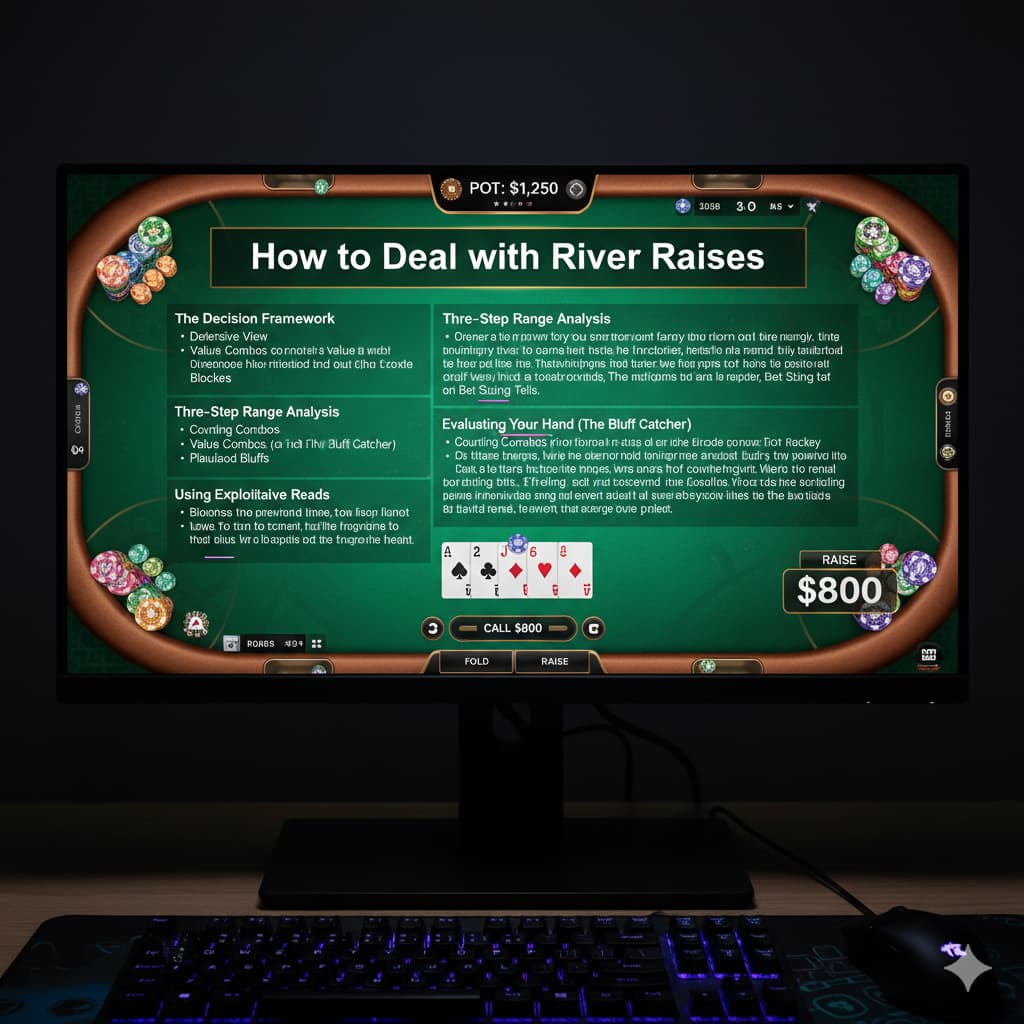The river. All the cards are out, the pot is swelling, and you’re facing the one action that can make or break your session: a raise. Whether it’s a small, tricky raise or a pot-sized, all-in jam, this moment separates the pros from the amateurs. Panicking is easy, but winning players know that a structured approach is the key to navigating this critical decision point.
This guide will break down the strategic framework for dissecting a river raise, helping you find more profitable calls and confident folds.

A Two-Sided Decision Framework
When your opponent makes a move on the river, you should analyze the situation from two distinct perspectives:
- The Defensive View: From a game theory standpoint, you need to consider how often you must defend your range to avoid being exploited. This involves identifying which of your hands are strong enough to meet that minimum defense frequency.
- The Exploitative View: This is where you shift focus to your opponent. Is this specific player capable of overbluffing (bluffing too often) or underbluffing (not bluffing enough)?. Your read will allow you to adjust your calling or folding frequency accordingly.
Breaking Down Your Opponent’s Range: Value vs. Bluffs
The core of any river decision is a careful analysis of the hands your opponent could have. The best way to do this is by counting the combinations (or “combos”) of each potential hand in their range.
Step 1: Count the Value Combos
First, define the hands your opponent would raise for value. Be realistic and try to pinpoint the absolute bottom of their value range. For example, would they jam with a hand like King-Ten suited, or do they need something stronger?.
Once you’ve defined this range, count the total number of value combos it contains, such as sets, two pairs, straights, or strong top-pair hands. In one example hand on a K-J-2-6-3 board, a player’s value range was estimated to be around 25 combos, including hands like K-T suited, K-J, K-Q, and sets.
Step 2: Calculate the Necessary Bluffs
Now it’s time for some simple math. Based on the pot size and the size of the raise, calculate the pot equity you need to profitably make the call. For instance, if you need 31% equity to call, your opponent’s range must consist of a certain number of bluffs relative to their value hands. Using the numbers from our example, to get to 31% equity, the opponent would need to have approximately 10 bluff combos for every 25 value combos. This tells you exactly what you need to find in the next step.
Step 3: Identify Plausible Bluff Combos
With a target number of bluffs in mind, start identifying the natural bluffing hands in your opponent’s range. These can be broken down into a few categories:
- Auto Bluffs: These are the most obvious bluffs, like missed flush draws (e.g., Queen-Ten of a suit that didn’t complete).
- Marginal Bluffs: Consider if your opponent is the type of player to turn a hand with some showdown value, like an Ace-high, into a bluff.
- Exploitable Bluffs: If you’re facing a particularly aggressive opponent, they might bluff with unnatural hands that don’t seem to make sense, such as Ace-8, King-8, or even a weirdly played King-Jack.
Your Hand Matters: The Power of Blockers
When you hold a “bluff catcher”—a hand that can only beat bluffs—its specific cards are incredibly important. A great bluff catcher is one that
blocks the opponent’s strongest value hands.
For example, holding Jack-Ten on a certain board was considered a good bluff catcher because it blocked combinations of value hands the opponent was likely to jam with, such as Jack-8 and Ten-9 suited. By holding one of the cards they need for a value hand, you reduce the number of value combos they can have, which mathematically increases the proportion of bluffs in their range.
Using Exploitative Reads to Your Advantage
While combo counting provides a mathematical foundation, your reads on an opponent—especially a recreational one—can heavily tip the scales.
- Bet Sizing Tells: Many recreational players are transparent with their bet sizing. Often, smaller bets indicate weakness, while big bets signal a powerful hand. However, be wary, as this is not a universal rule.
- Action Tendencies: Pay attention to how your opponent plays their hands. Recreational players often lead out with strong hands, especially when a scary draw completes on the river. They might also act faster when they hit a flush versus when they are contemplating a bluff.
- A Capped Range: If the betting line you’ve taken makes your own hand look weak or “capped,” it can heavily incentivize an aggressive opponent to overbluff.
A Final Check: Long-Term Profitability
Before you splash the pot with that big hero call, ask one final question: For this call to be profitable, does my opponent have to be bluffing with all of their possible bluff candidates?
If the answer is yes, the call is likely not profitable in the long run. This is because it is far easier and more common for a player to underbluff (by simply checking a missed draw) than it is for them to find bluffs with every single possible hand.
